|
Reflections
& Commentary: Page 6
|
| Occasional Increased Difficulty & Traditional Roots |
 |
| An
Occasional Hard Problem . . . I didn't always suffer from a relatively short attention span. For example, in 1978, at the age of 41, I made the FA of a problem near Pueblo, CO that required several intensive visits. I called it the Groove somewhat tongue in cheek, for it involved pulling rapidly into a difficult "Gaston" type position in a shallow overhanging depression while transitioning to dynamics to a small lip above. The Gaston is severe: Bob Williams, an outstanding boulderer, tore his chest cartilage on his first visit. This was one of the last hard boulder problems I established. I had done some isolated moves back in the 1950s that probably were as hard, or harder, but they were mostly exercises and didn't lead anywhere. Jim Holloway repeated this problem, which does not allow reaching off to the right or left of the Gaston, only going straight up from the position in the photo. Jim also did a problem on the left side of this overhanging face that left me on the ground! |
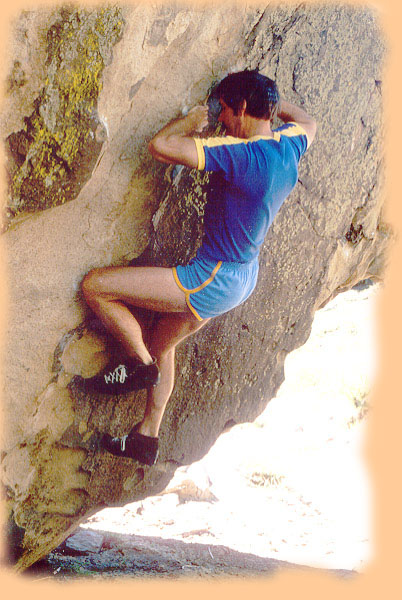 "On the Fatted Calf boulder, west of Pueblo, there is an overhanging groove, on which John was able to pull laterally, do a technical dynamic spring to a hold over the lip, hang on with one hand, and pull over the top." - Chris Jones in Master of Rock. |
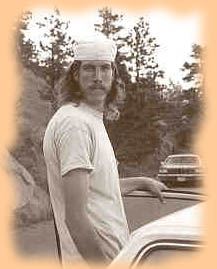 |
Jim
Holloway was in the the vanguard of a new and
superior generation of boulderers who would surpass many of my best
efforts fairly quickly. I was fortunate to have started at an earlier
time, before most of them were born! He was at least 6'4", slim,
powerful, and as graceful as a Russian gymnast.
Go to "My Bouldering Companions" and click on Holloway's name
to view a profile of America's early bouldering superstar. Holloway retired from climbing while still at his peak about 1980. He turned to bicycle racing and was seriously injured in a road accident. He recovered and became an artisan, designing and handcrafting beautiful furniture. Let's hope that, in the future, young boulderers will be as adaptable to life's provocations. |
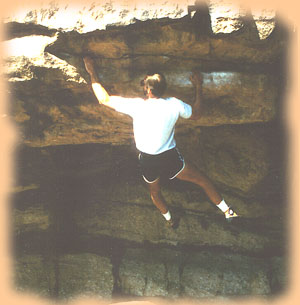 Tarzan Traverse at Little Owl Canyon, 1986, Age 49 - goes from the climber's right, to his left |
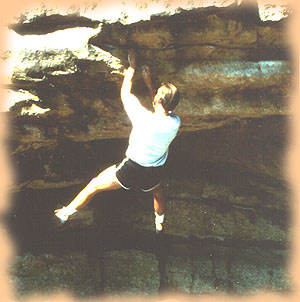 An arm-intensive, gymnastic eliminate problem, entirely avoiding the two large pockets above my head in the first photo (on left). Exits around the corner to the left or straight up from the second photo. |
| Among my last efforts . . . Arms only: pure gymnastic bouldering |
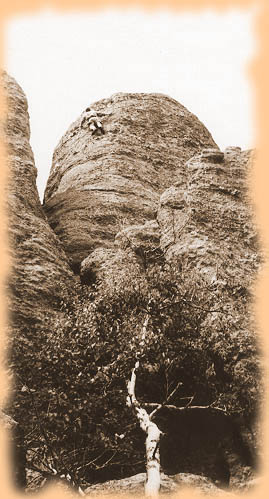 Queen Pin, Needles mid 1960s (A Royal Robbin's climb) |
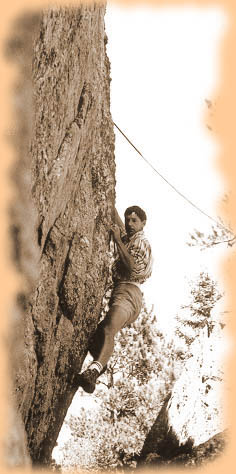 Direct Start on the Kamps-Powell Route, Paydirt Pinnacle 5.12+ , 1965 (avoids slab on right where one stems over on the K-P Route) |
|
Traditional
Roots . . .
As a traditional climber I made a number of minor first ascents and did other climbs in the Tetons (Summit of the Grand in 1956) and the Black Hills' Needles ( Cathedral Spires ). One of these was my route up the aid crack on the south face of Baxters Pinnacle, above Jenny Lake, in July, 1958 (the first 5.10 pitch in the Tetons). Out of Garnet Canyon I led the FAs of several multi-pitch ridges and buttresses - 300' to 1,000' - on the south face of Disappointment Peak , including Delicate Arete(5.9/5.10), the Fifth Column(5.9), direct south ridge of the Watchtower(5.8), south face of Grunt Arete(5.7), and the Knob(5.9). All of these climbs were done in the late 1950s. Numerous FAs in the Needles of the Black Hills of SD, including: 2 variations(5.11/5.12+) on Paydirt Pinnacle[1965], Molar [1966](5.9-5.10), Safety Pin, Gnomon Ck[1965](5.10), Javelin[1964](5.9), Incisor(5.9), etc. |
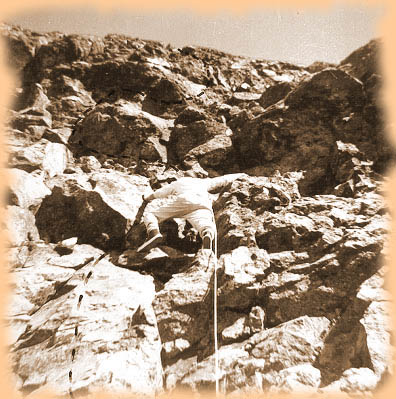 Mt. Thielson 1956 |
| I did a lot of established trad climbs, some of which were
2nd or 3rd ascents, like the immensely popular Irene's Arete
(2nd asc) and the north faces of Teewinot(5.8) and Cloudveil
Dome(2nd ascent) in the Tetons, and the Queen Pin
(2nd asc) and
Cerberus , and the South Tower(2nd
asc) in the
Needles. In Oregon, I climbed several mountains, including Mt. Thielson (1956). Here's a shot taken on top another Cascade peak in the early summer of 1956. And, in this photo taken later in 1956, I have been requested to read the Teton Guidebook after our party climbed the wrong mountain. |
 Hangover Pinnacle, Tetons 1956 Block of chalk in my shirt pocket |
I might also add that
although I did well as a traditional
climber on free ascents up to about a thousand feet, I lacked the
skills, temperament, and interest that climbers like Robbins and
Chouinard had for longer, more sustained and technical projects. The
sieges of Yosemite, enabled my massive amounts of equipment, held no
attraction for me. I climbed mostly during the piton era,
never using more than a few pins on my ascents,
none for aid. I didn't carry a "rack", just a small selection
of pitons and carabiners. I occasionally placed protective
bolts on lead - with a manual twist-drill. I led virtually
all of my climbs.
|
| Here's a recorded commentary by Yvon Chouinard addressing my
divertissements and describing the state of climbing in those days: "At that time Gill
was doing some
climbs on Disappointment Peak. After grabbing whatever climbing partner
he
could find, he'd do some arete that often wouldn't lead
anywhere, because Disappointment Peak is just a big flat
thing on top. Kamps and I did Satisfaction Buttress, and it was the
hardest climb in the Tetons when we did it, yet the
American Alpine Journal refused to publish anything about it because it
didn't have a summit. If it didn't have a summit, you didn't really do
a climb. Gill was getting even more ridiculous and was doing things
just for the sake of pure climbing, going nowhere. These were absurd
climbs, as far as the American Alpine Club was concerned."
|
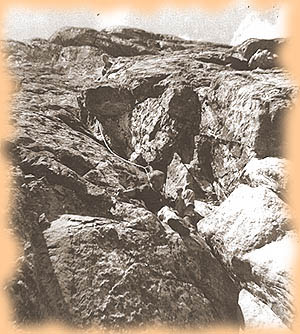 Bob Toeple (below) & me on Teton rock, 1956 |
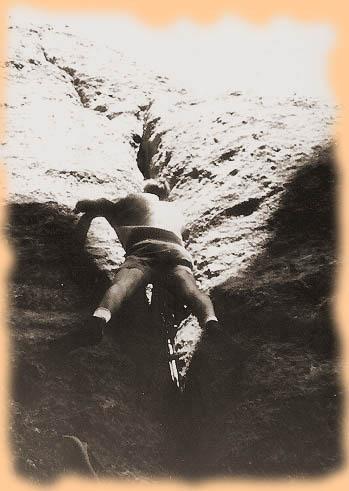 2nd Ascent of the Bayonet (5.9), Needles 1964 Photo Ray Schrag |
Some of
my climbs were more like bouldering rambles. If the obvious
course - up the crest of a new ridge, say - looked uninteresting I
would
improvise on adjacent rock, making my ascent more challenging. This
occasionally
frustrated other climbers who went up to do the route and found if you
took
the easiest way - a mountaineering tradition - you didn't get much of a
climb!
Eventually, the AAC evolved conceptually to the extent that I was asked by Jim McCarthy, its Secretary (and future President), to write an article describing the "new" sport of bouldering ( The Art of Bouldering , Journal of the American Alpine Club (1969)). Read excerpts of this article (it makes me a bit queasy when I read it after 36 years.) |
| Campground
Days in the
Tetons . . . I have many happy memories of bouldering and climbing with Yvon and others in the Tetons during the mid and late 1950s and early 1960s. In the mid 1950s we camped at Jenny Lake, but by 1958 the Park Service had developed a separate campground for climbers, situated well away from normal folks. Here are some recollections of that time in a short, unpolished essay entitled Tales of the Climbers' Campground . |
Continue to Page 7 Return to Page 1